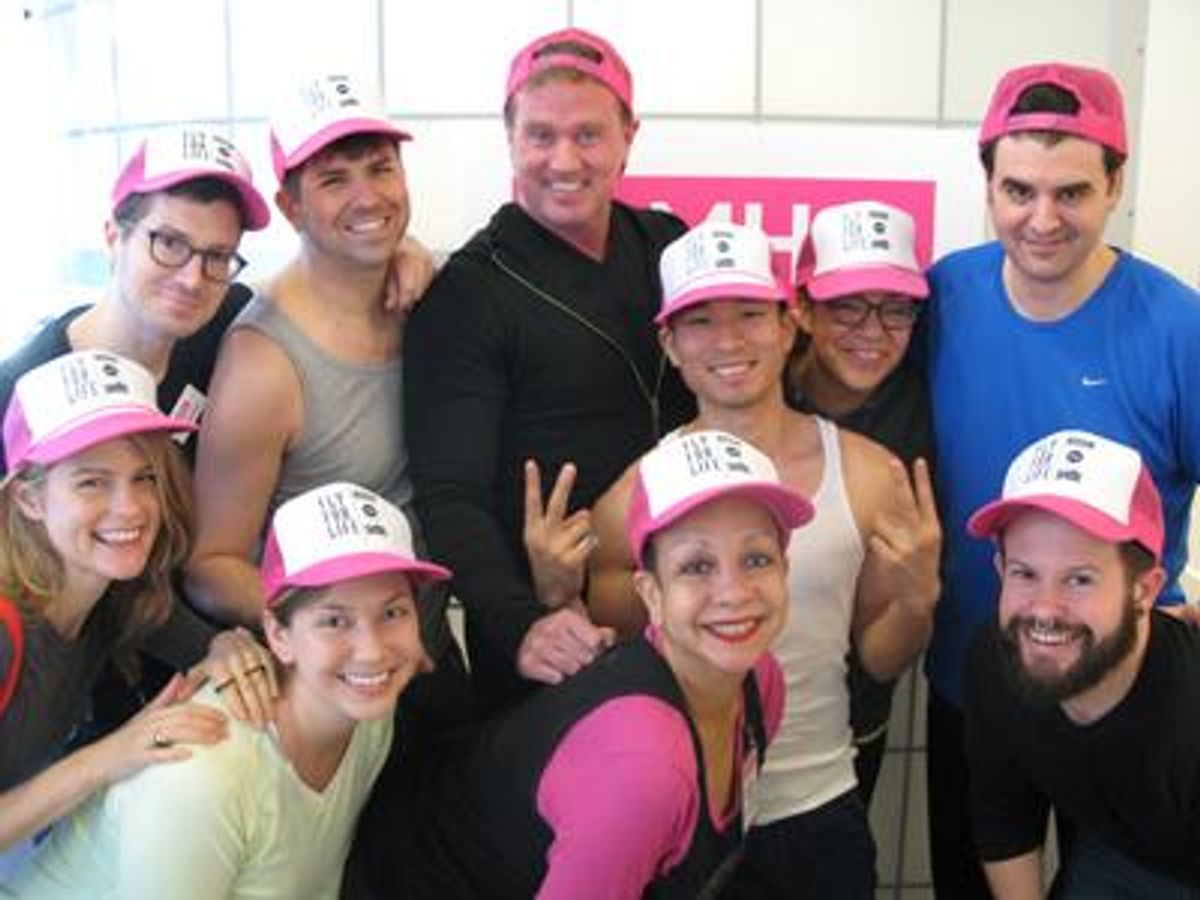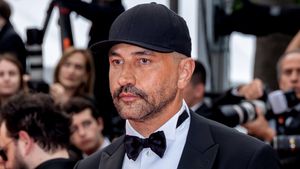Charlie Finlay was a closeted gay high school student when leader Harvey Milk was killed by an angry colleague, Dan White. He can still remember how traumatized he was about the assassination and how it overlapped with his own fears about coming out. Raised a good Irish Catholic boy, Finlay had to fight his own internalized homophobia, as well as the homophobia surrounding him, for years — until he was finally brave enough to come out at the dawn of the AIDS crisis in 1981.
“I finally felt liberated enough to come out,” Finlay said, “and all of a sudden there was this thing. This, ‘Have you heard?’ … It was the scariest time of my life. I was taking my first steps out into the gay community, and I felt so afraid.”
But then Finlay heard about a group of gay men and women coming together in New York City to fight back. That group was Gay Men’s Health Crisis (GMHC), and knowing these activist-educators were out there helped him feel like he wasn’t alone as a gay man.
“It made me feel so proud to be a gay man,” he recalled.
Finlay officially joined GMHC as an employee doing fundraising in 2004 and he worked there for five years.
“I was here for some really great and [some] hard times,” he said. He left the non-profit in 2008, lured away by the chance to make more money at another organization. Almost immediately, however, he found something missing.
“The piece that was missing was my connection to the community,” he said. So he returned to the fold and began consulting for GMHC in 2012.
Later that year, Finlay’s life changed.
“While I was here consulting, I had some health issues,” Finlay said. He thought at first the problems to be routine. “But I got the news that I had tested HIV-positive in November of 2012.”
He found out in the GMHC offices over a phone call with his doctor. His partner had also tested positive before him.
“I was just shocked,” Finlay said. “I couldn’t believe it. I got off the phone and my first reaction was just to hide it, to tell no one because I felt ashamed that I knew so much about HIV, and that I was still infected."
Today Finlay takes medication daily to suppress his viral load, he and his partner are still together, and he credits his survival to where he was when he got the news: GMHC.
“People here took care of me in a way that was so inspiring and in a way that they do every day, day in and day out. They took care of me, they made sure I was OK,” he said. “I don’t know what I would have done had I gotten that news in a different place. And I think there was some, for lack of a better word, divine intervention. There was some reason I got the news here.”
It’s the support Finlay received from the staff members at GMHC that brought him back full time as a fundraiser. And it is that support, he says, that makes GMHC relevant to this day to thousands of HIV-positive people.
Recent Changes
In late 2013, GMHC parted ways with its long-time CEO Marjorie Hill (pictured below). She had been the head of the organization for seven years and her departure was a topic of gossip among both health activists and LGBT organization watchers. Though some gay media outlets have criticized Hill, and by extension GMHC, there's no debating that nationally she was one of the most respected leaders of an AIDS service organization in the U.S. She was also one of the few lesbians who was still managing an AIDS service organization in the country (something common in the 1990s as the epidemic grew, but less so once men were able to live longer on antiretrovirals; Laurie Lang at Project Angel Food being the exception).

Regardless of why, or at whose insistence, Hill departed, experts say that an organization is made of up of many people, not just its CEO. With Janet Weinberg in the post on an interim basis, GHMC is sending a strong, clear message that their work isn’t done yet. In fact, expansion is on the ticket in 2014 — and they've got the money to do it.
Like many non-profits, half of GMHC's budget is dependent upon government financing, and Weinberg said the bigger grants are often the most helpful in terms of making a real impact. The organization received three substantial government grants for work this year, perhaps the most exciting to Weinberg is $1.2 million grant that funds them doing a first-of-its-kind pilot program to help HIV-positive people with job training and placement.
“The beauty of that grant is that we believe that one of the pieces that prevents people with HIV from even attempting to work is that if they do, within months, their safety net goes away,” Weinberg said, because any income from work can signal an end to any disability benefits the person might receive. Often people have had to leave their jobs because of periods of severe illness. But many who physically feel ready to return to work are left worrying about the "what ifs."
“That would be a barrier to returning to work," Weinberg said. "If you know that you’ve had spells of illness … [or] that you very well may not succeed, despite how hard you’ve fought just to get the survival benefits that you’re on [you could lose them].”
With the grant, GMHC can set up a program to help people train and re-enter the workforce while navigating obstacles that may stop them them from maintaining a safety net or reaquiring benefits if employment does not work for them, Weinberg explained.
The U.S. Department of Health and Human Services also granted GMHC $1.5 million over five years to expand testing, prevention, and care services for Puerto Rican gay men and other men who have sex with men. The goal is to help Puerto Rican gay and bi men who are at high risk of HIV infection, those who are infected with HIV but unaware of their HIV status, others who know they're positive but have never accessed medical care, or those who have dropped out of care. The program may be more successful than other outreach programs because it will rely on HIV-positive Puerto Rican gay and bi men to recruit others through social networks to get in and get tested, and if positive, to get into care — and stay in care.
The program is a big deal because right now in the U.S., Latino men who have sex with men account for almost one in every four new infections among all gay and bi men. In New York City alone, 68 percent of Hispanic/Latino males diagnosed with HIV are classified as men who have sex with men.

Above: GMHC's annual AIDS Walk
Weinberg said GMHC's new partner, Mount Sinai Hospital, will also help keep these new clients engaged in care with a bilingual staff, "culturally-sensitive supportive services in a location that is known as being gay-friendly and sex-positive." The program also includes mental health counseling, support groups, transportation assistance, health insurance, advocacy for health insurance, and housing assistance.
Demetre Daskalakis, MD, medical director of HIV ambulatory care services at Mount Sinai Hospital, said the hospital is a good fit because it has long been a leader in HIV prevention and LGBT health in New York City.
Another part of their outreach to men of color has already begun using a much smaller grant from the federal Substance Abuse and Mental Health Services Administration for an HIV prevention project dubbed Your Realness. It uses social media including Instagram, Twitter, Facebook, Youtube, and mobile dating apps to reach African-American and Latino gay and bi men as well as transgender women between ages 14 and 29 who are part of New York's storied House and Ball community. Ball culture goes back decades but was made famous by Jenny Livingston's 1990 documentary, Paris is Burning. The House and Ballroom community is made up predominately of African-American and Latino LGBTQ individuals, where a group (or "house") is considered a club or "surrogate family" and older members often provide support for LGBTQ youth who otherwise might be homeless or without any support from their biological families. Members of the houses, both young and older, compete in balls, which are competitions in various categories (such as walking the runway and vogueing) for trophies and cash prizes.
The goal of Your Realness is to get these young people talking, encouraging healthier behaviors around substance use and HIV risk, and get them connected to HIV testing, prevention, and services. GMHC is hoping to reach more than 3,000 young people with this initiative, which utilizes GMHC's 20-year relationship with the House and Ball community.
"We are uniquely positioned in the community as the host of the Latex Ball, the largest annual Ballroom event, and as a respected HIV prevention service provider to make great impact through social media," Weinberg said. "GMHC's longtime relationship with House and Ball leadership and members has allowed us to gather important data on HIV prevention."

Above: Mark Ruffalo and Taylor Kitsch in The Normal Heart
The Largest Grant
The third new venture that GMHC is rolling out this year is courtesy of a $9.6 million grant to help provide housing assistance to HIV-positive persons.
“People who are unstably housed resort to anything and everything for survival,” Weinberg said. “So we know they are [often] unable to take medication. If you are sleeping in somebody else’s home, you may not feel comfortable to pull out your HIV meds. Some meds require refrigeration, and you may not have that available.”
Those difficulties make this new housing grant among the most important, especially in concert with the other grants. It’s part of what Weinberg and other GMHC workers call “wrap-around service,” which goes beyond one part of being HIV-positive. That sort of service delves into mental health, housing, medication adherence, and takes a fuller picture of an individual's needs.
“I think we really look at the individual holistically,” said Lynette Ford, GMHC’s managing director of program services and evaluation. “You cannot focus on only one issue, because issues don’t exist in a bubble. You really have to look at the client from a psychosocial perspective.”
Also part of that wrap-around service: the new partnership with Mount Sinai Medical Center immediately matches those who test positive with stable medical care.
“This collaboration shows two things: When you have committed staff who are committed to a common mission and share common values, you can really positively impact not only individuals, but their health outcome,” Ford said. “Mount Sinai and GMHC are two big organizations, and in the AIDS world, sometimes organizations, for lack of a better word, don’t collaborate strategically. But this has been a really effective partnership.”
So far, some HIV-positive clients with viral load counts exceeding one million, have reduced their count down to being undetectable within less than a year through the program's availability to stable care.
Additionally, GMHC is looking to expand its substance abuse and mental health care beyond what grants already cover, said Bill Bracker, M.D., GMHC's managing director of health care and business strategies development. Future plans include opening clinics to treat a broad spectrum of people's mental health and drug abuse concerns, including heterosexual men, women, and individuals whose income is too high to fall under a grant’s purview.
Back to the Beginning
GMHC may also capitalize on the upcoming HBO film, The Normal Heart, the upcoming movie based on the play by co-founder Larry Kramer, essentially the roman à clef of his time at GMHC. Kramer apparently worked with filmmakers to add about 40 percent new material to the movie, which comes out this May. By now the founding of GMHC is both legendary and filled with plenty of drama.
"The Normal Heart is really the story of GMHC," communications director Krishna Stone points out.
After men in San Francisco and New York began to come down with what was then dubbed the “gay cancer” (it was actually complications from AIDS, particularly a rare cancer called Kaposi's Sarcoma), people in the community began to worry. In 1981, about 80 gay men came together in Larry Kramer’s New York apartment to talk about the new epidemic, forming the first-of-its-kind organization, the Gay Men’s Health Crisis.
The non-profit group’s founders included the ever-outspoken Kramer, Paul Popham (who served as the group’s president for several years), Lawrence D. Mass (who, in 1981, wrote the first media report on AIDS for the New York Native), Paul Rapoport (who later helped found New York’s LGBT Community Center, Nathan Fain, and famed author Edmund White. (In a recently unearthed archival letter, Fain reminded Kramer, who became synonymous with the organization and whose voice became larger than life at times, that these he may have been the instigators but the founding of GMHC was more of “a tribal republic taking form.”)
In 1982, an answering machine in the home of volunteer and the group's first president Rodger McFarlane became the world's first AIDS hotline. It received over 100 calls the first night. McFarlane, who died in 2009, was said to have created the organization that is at the heart of GMHC (Kramer even noted that after McFarlane's death) and many of the programs he started like mental health counseling, legal assistance, the buddy program that helped Charles Finlay cope with his own diagnosis are still alive today. Two years later Kramer left to co-found the more aggressively political ACT UP while GMHC began working with the CDC on HIV research and serving indvidual clients, not just gay men but anyone impacted by HIV or AIDS.
Today for Finlay, Stone, and the others employees at GMHC — more than a few who have been with the organization not just for years but for decades — the reason GMHC is enduring is simple: their work is not done.
“GMHC is here because AIDS is not over,” Finlay said. “I think this agency is amazing, and I feel privileged and honored to come back and work and to fundraise for the work we do. … The epidemic is controlled by medication, but it’s not over. And we’re gonna be here until it’s over.”














































































